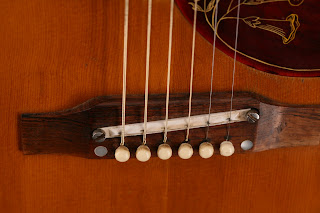
Perhaps no other Gretsch model is as famous and ubiquitous as the Country Gentleman; this model was seen by 73 million viewers strapped around George Harrison on February 9th, 1964 when the Beatles made their debut on the Ed Sullivan Show.
After the show, Gretsch was flooded with orders for not only this model (which was quite expensive at the time), but for their other guitars as well. The company was given a super boost in the form of free advertising that money simply can't buy, and their production ramped up as a result.
Models made (between '62-early'64) with the exact 'Harrison" specs are quite scarce, as various subtle hardware changes began to be seen in 1963 on this model, which included the addition of Gretsch's newly designed "Supetron" pickup in the neck position in mid-64. By 1967 (the highest year of production for Gretsch), the Gent was back to having two Filtertron pickups (as seen here- these are the 'classic" Gretsch low-output humbucking design, also as seen and heard in the "Harrison spec" guitars). The Country Gent is a large guitar, measuring 17" across the lower bout.
Other quirky Gretsch design features are seen on this guitar, namely the painted on "f" holes and the back pad. The faux "F" holes were Chet Atkins idea; he liked the traditional look of the "f" hole, but wanted a closed body to increase sustain and limit feedback howl (it works!). The back pad was Gretsch's way of compensating for loading electronics into the closed body; snap off the back pad and there's a plastic covered, screw off hatch which allows full access to the electronics.
This beautiful example has survived in excellent condition. Gretsch guitars have developed a reputation for "falling apart", mostly due to the celluloid based plastic used on their binding having a tendency to rot away. This is not limited to Gretsch guitars, as many instruments from Gibson, Epiphone, C.F Martin and D'Angelico have also suffered a similar fate in both binding and pickguard material crumbling away due to this unstable material.






images courtesy of the author; c2012 Derek See.















































